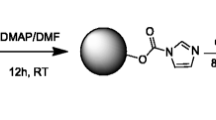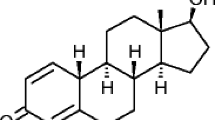Abstract
For point-of-care testing of the illegal fortification of repaglinide (Rep) in natural dietary supplements, a competitive chemiluminescent immunoassay (CLIA) was established, using a horseradish peroxidase (HRP)–luminol–H2O2 system for signal amplification. Polyclonal antibodies for Rep were produced via immunization technique. Following optimization of the enzyme reaction time and concentrations of antibody and coating antigen, the method showed a limit of quantification (LOQ) of 1.0 ng/mL in PBS and limit of detection (LOD) of 8.3 ng/mL in serum and 6.0 ng/mL in blank tablets. When applied in natural dietary supplements, the method provided results consistent with those from HPLC, suggesting that the proposed method could be used for rapid screening of Rep in natural dietary supplements and detecting Rep in serum after administration.

A sensitive chemiluminescent immunoassay for rapid analysis of repaglinide in natural dietarysupplements and serum








Similar content being viewed by others
References
Owens DR (1998) Repaglinide–prandial glucose regulator: a new class of oral antidiabetic drugs. Diabet Med 15:S28–S36. doi:10.1002/(SICI)1096-9136(1998120)
Bech P, Moses R, Gomis R (2003) The effect of prandial glucose regulation with repaglinide on treatment satisfaction, wellbeing and health status in patients with pharmacotherapy-naive type 2 diabetes: a placebo-controlled, multicentre study. Qual Life Res 12:413–425. doi:10.1023/A:1023495106160
Hasslacher C (2003) Safety and efficacy of repaglinide in type 2 diabetic patients with and without impaired renal function. Diabetes Care 26:886–891. doi:10.2337/diacare.26.3.886
Hatorp V, Huang WC, Strange P (1999) Pharmacokinetic profiles of repaglinide in elderly subjects with type 2 diabetes. J Clin Endocrinol Metab 84:1475–1478. doi:10.1210/jc.84.4.1475
Gumieniczek A, Berecka A, Hopkala H (2005) Quantitative analysis of repaglinide in tablets by reversed-phase thin-layer chromatography with densitometric UV detection. J Planar Chromatogr Mod TLC 18:155–159. doi:10.1556/JPC.18.2005.2.12
Gandhimathi M, Ravi TK, Renu SK (2003) Determination of repaglinide in pharmaceutical formulations by HPLC with UV detection. Anal Sci 19:1675–1677. doi:10.2116/analsci.19.1675
Soni LK, Narsinghani T, Jain M (2012) Development and validation of RP-HPLC method for simultaneous estimation of metformin hydrochloride and repaglinide in tablet dosage form. J Liq Chromatogr Relat Technol 35:385–392. doi:10.1080/10826076.2011.601492
Ho EN, Yiu KC, Wan TS, Stewart BD, Watkins KL (2004) Detection of anti-diabetics in equine plasma and urine by liquid chromatography–tandem mass spectrometry. J Chromatogr B 811:65–73. doi:10.1016/j.jchromb.2004.03.070
Zhang J, Gao F, Guan X, Sun YT, Gu JK, Fawcett JP (2011) Determination of repaglinide in human plasma by high-performance liquid chromatography–tandem mass spectrometry. Acta Pharm Sin B 1:40–45. doi:10.1016/j.apsb.2011.04.004
Jiladia MA, Pandya SS (2009) Estimation of repaglinide in bulk and tablet dosage forms by HPTLC method. Int J Pharm Pharm Sci 1(Supp 1):141–144
De Boever J, Kohen F, Usanachitt C, Vandekerckhove D, Leyseele D, Vandewalle L (1986) Direct chemiluminescence immunoassay for estradiol in serum. Clin Chem 32:1895–1900
Dodeigne C, Thunus L, Lejeune R (2000) Chemiluminescence as diagnostic tool. A review. Talanta 51:415–439. doi:10.1016/S0039-9140(99)00294-5
Maters AW, Wright CV, Lee MT, Schwichtenberg G, Detrick B (2012) Detection of type-specific antibodies to HSV-1 and HSV-2: comparative analysis of a chemiluminescence immunoassay with a conventional ELISA. Diagn Microbiol Infect Dis 73:273–274. doi:10.1016/j.diagmicrobio.2012.03.023
Zhang Y, Lu S, Liu W, Zhao C, Xi R (2007) Preparation of anti-tetracycline antibodies and development of an indirect heterologous competitive enzyme-linked immunosorbent assay to detect residues of tetracycline in milk. J Agric Food Chem 55:211–218. doi:10.1021/jf062627s
Hermanson GT (2013) Vaccines and immunogen conjugates. Bioconjugate techniques, 3rd edn, vol 19. Pierce Biotechnology/Thermo Fisher Scientific, Rockford, pp 839–865. doi:10.1016/B978-0-12-382239-0.00019-4
Xin TB, Chen H, Lin Z, Liang SX, Lin JM (2010) A secondary antibody format chemiluminescence immunoassay for the determination of estradiol in human serum. Talanta 82:1472–1477. doi:10.1016/j.talanta.2010.07.023
Qin QP, Peltola O, Pettersson K (2003) Time-resolved fluorescence resonance energy transfer assay for point-of-care testing of urinary albumin. Clin Chem 49:1105–1113. doi:10.1373/49.7.1105
Acknowledgment
This work was received financial support from the National Natural Science Foundation (No. 81173017, No. 31101277), the National High-Tech Research and Development Program of China (863 Program) (No. 2014AA022303), Tianjin Science and Technology Program (No. 11ZCGHHZ01200, No. 12ZXCXSY08400, No. 12JCQNJC08900), and Tianjin Research Program of Application Foundation and Advanced Technology (13JCZDJC29700).
Author information
Authors and Affiliations
Corresponding authors
Additional information
Lei Zheng and Jing Wang contributed equally to this work.
Rights and permissions
About this article
Cite this article
Zheng, L., Wang, J., Wang, Y. et al. A sensitive chemiluminescent immunoassay for point-of-care testing of repaglinide in natural dietary supplements and serum. Anal Bioanal Chem 407, 1973–1980 (2015). https://doi.org/10.1007/s00216-015-8462-3
Received:
Revised:
Accepted:
Published:
Issue Date:
DOI: https://doi.org/10.1007/s00216-015-8462-3




